Hello all- or anyone around! I figured I should just add a short blog-style post here given that well… it’s a blog, and I hope it’s stylish! Ah hah enough of the jokes. Anyhow-
It’s been a slow few months for me psychologically- being home is taking a toll, and publishing my MSc thesis has become more of a dream at this point given that psychological state. That being said, I am enjoying myself quite a bit!





Above you’ll see a lil’ gallery- I’ve taken up “making” as they call it- just basic circuitry and the like, have gotten a fair few macro shots recently, have been working on astronomical catalogue reduction techniques (here you see some local LSR clipping- I’ll describe that a bit another time!) and also have some shots from Madeira on my recent trip to see milady!
The end goal for the circuitry you ask? A bat recorder- one that’s just as good as the Audiomoth (for what I need at least) and one that is also cost effective- that I can do myself easily too with my own firmware for it. “Why?” you might ask… well, seems like it’d be fun! I plan to include temperature/humidity sensors onboard to provide extra data which would indeed prove useful for data science, including an optional solar module too. Anyway- it’ll keep me occupied for a while! I have to admit though- soldering is damned fun!
I’ll describe the LSR bit now I suppose. When reducing an astronomical catalogue, if you want to deal with non-disc stars, you tend to do what’s called an LSR-cut. “Local Solar Rest”-cut. That is to say, a star that is moving near to the local disk velocity *emphasis* is likely to belong to the disk at that point. Generally in a survey you end up doing an LSR cut w.r.t our local disk velocity- but why that?
Well, generally you’re trying to remove field stars from our local neighbourhood- pesky as they are. Well, you can also do a general LSR cut- i.e. remove all stars if they’re close to their local disk velocity. You might ask “Well, why the hell would I do that? That removes all the disk stars!” Well when it comes to stellar streams, that might just be quite useful- here’s a cut *without* that adaptive bit, just using a static value for the LSR velocity.


Mind you, this is all just based on what I’ve been told by my supervisor (ex-supervisor?… mentor- that sounds best, he is quite great.) It makes sense though- that big green clump is what we’re after, and the red clump is mainly disk stars that are more similar to our sun. Obviously the “adaptive” method is best- you avoid losing too many of the more useful stars! Much more conservative.
Anyway… what else is there… well, not much. I’ve added some extra photos to the site, and am currently processing my Madeira catalogue from the latest trip- I will make sure to update the site for those once I have them done and release another relaxing music-photo video for them. Until then, enjoy yourselves! I need to find a job though- my funds are running out, and solder/flux aren’t cheap!